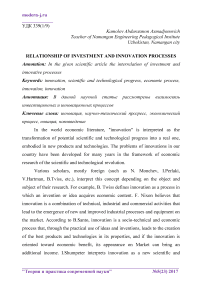Relationship of investment and innovation processes
Автор: Kamolov A.A.
Журнал: Теория и практика современной науки @modern-j
Рубрика: Международные экономические отношения
Статья в выпуске: 5 (23), 2017 года.
Бесплатный доступ
In the given scientific article the interrelation of investment and innovative processes
Innovation, научно-технический прогресc, scientific and technological progress, economic process
Короткий адрес: https://sciup.org/140289402
IDR: 140289402
Текст научной статьи Relationship of investment and innovation processes
In the world economic literature, "innovation" is interpreted as the transformation of potential scientific and technological progress into a real one, embodied in new products and technologies. The problems of innovations in our country have been developed for many years in the framework of economic research of the scientific and technological revolution.
Various scholars, mostly foreign (such as N. Monchev, I.Perlaki, V.Hartman, B.Tviss, etc.), interpret this concept depending on the object and subject of their research. For example, B. Twiss defines innovation as a process in which an invention or idea acquires economic content. F. Nixon believes that innovation is a combination of technical, industrial and commercial activities that lead to the emergence of new and improved industrial processes and equipment on the market. According to B.Santo, innovation is a socio-technical and economic process that, through the practical use of ideas and inventions, leads to the creation of the best products and technologies in its properties, and if the innovation is oriented toward economic benefit, its appearance on Market can bring an additional income. I.Shumpeter interprets innovation as a new scientific and organizational combination of production factors, motivated by entrepreneurial spirit. In the internal logic of innovation - a new moment of dynamization of economic development.
Analysis of various definitions of innovation leads to the conclusion that the specific content of innovations is made up of changes, and the main function of innovation is the function of change.
Innovation can be considered in both a dynamic and a static aspect. In the latter case, innovation is represented as the final result of the research and production cycle. In other words, we have the fact of innovation as a phenomenon.
At the same time, innovation as a process is the creation, mastering and diffusion of innovations. Scientific and technical developments act as an intermediate result of the research and production cycle and, as practical applications are transformed into scientific technical innovations. Thus materialization of new ideas and knowledge in the production process takes place with the aim of their commercial implementation to meet new consumer needs. In other words, scientific and technical novelty and industrial applicability are the indispensable properties of innovation as a phenomenon. Commercial realizability in relation to innovation acts as a potential property, for the realization of which certain efforts are needed.
From what has been said, innovation as a phenomenon must be seen as inseparable from innovation as a process.
It should also be noted that in practice the notions of "innovation", "innovation", "innovation" are often identified, although there are certain differences between them. Innovation can be a new order, a new method, an invention. Innovation means that innovation is used. From the moment of acceptance to distribution, innovation acquires a new quality and becomes an innovation.
As already noted above, the innovation process, as a rule, is impossible without investments ("investment in innovation"). Based on the results of numerous studies conducted in the United States, the economic return on investment in innovation exceeds the payback in any other sphere of financial resources and is at the level of 35-50%. If we take into account the co-benefits for the society as a whole, which are often much greater than the direct effect of the initial designation, investments in innovation and the science that feeds them are the most effective way of allocating finance capital.
One aspect of resolving the problem is the integration of the efforts of all participants interested in the commercialization of technologies: the private sector, research and training organizations, and the state.
Even more important is the qualitative level of the most innovative process (or the process of commercialization of technologies identical to it) that determines the possible success of the project - the ratio of the level of financial return to the initial investment, as well as the risks of participants in the implementation of the investment.
Taking into account all the above factors of increasing the role of innovation in the lower economy and access to financial resources in the field of technology commercialization, it can be argued that venture capital as a specific type of financing designed specifically for investment in high risk projects, primarily innovative, plays a critical role .
The introduction of innovations into the economic life of the organization naturally requires the investment of financial resources in their development and development. At the same time, an empirical dependence is established - the more profit from innovation it expects to receive in the future, the organization, the more it must be ready for the present in the high costs.
Nevertheless, for the organization the problem of choosing the object of financial investments is not limited to the maximum amount of investments. Studies have shown that investments in innovation are the most effective, where the organization has the opportunity to receive monopoly superprofits. In other words, investments in innovations that develop the distinctive abilities of an organization are most profitable.
Used sources:
Список литературы Relationship of investment and innovation processes
- Management of the organization / Ed. AGPorshneva, Z.P. Rumyantseva, N.A. Salomatin. - Moscow: Infra - M, 1999.
- Fundamentals of commercialization of the results of NPOKR and technology / Comp. N.M. Fresheret. M.: ANH, 1999


